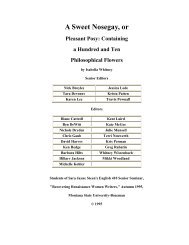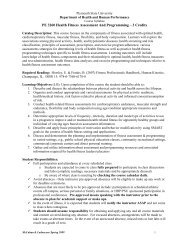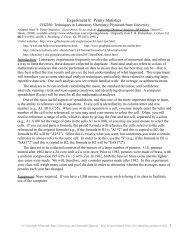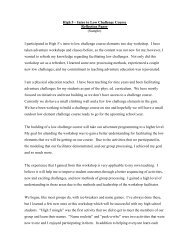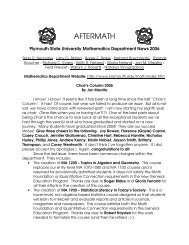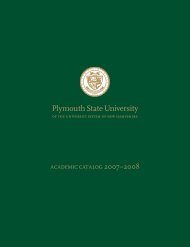'Music & a Story': Sound Writing in Ramabai Espinet's The Swinging ...
'Music & a Story': Sound Writing in Ramabai Espinet's The Swinging ...
'Music & a Story': Sound Writing in Ramabai Espinet's The Swinging ...
Create successful ePaper yourself
Turn your PDF publications into a flip-book with our unique Google optimized e-Paper software.
“MUSIC AND A STORY”:SOUND WRITING IN RAMABAI ESPINET’S THE SWINGING BRIDGE.Njelle HamiltonWITH essays entitled “<strong>The</strong> Absent Voice: Unearth<strong>in</strong>g the Female Epistemology of Cane,” and“<strong>The</strong> Invisible Woman <strong>in</strong> West Indian Fiction,” <strong>Ramabai</strong> Esp<strong>in</strong>et, Indo-Tr<strong>in</strong>idadian Canadianpoet, scholar and novelist, has made clear her longstand<strong>in</strong>g concerns with the erasure of Indo-Caribbean women <strong>in</strong> the literature, culture, and politics of the region. 1 Her 2003 novel <strong>The</strong>Sw<strong>in</strong>g<strong>in</strong>g Bridge is a clear contestation of that erasure, <strong>in</strong> its almost manifesto-like voic<strong>in</strong>g of theIndo-Tr<strong>in</strong>idadian female experience. Perhaps because of this, scholars have almost exclusivelybeen <strong>in</strong>terested <strong>in</strong> the novel’s depiction of gender, sexuality and ethnicity, focus<strong>in</strong>g <strong>in</strong> particularon the exilic experience of the first-person narrator, Mona S<strong>in</strong>gh, and the <strong>in</strong>denture experience ofher great-grandmother, Ga<strong>in</strong>der, a chutney s<strong>in</strong>ger. 2Although music constitutes a major part of the novel and plays a significant role <strong>in</strong>Mona’s self-conceptualization, scant scholarly attention has been paid to the range of musicforms <strong>in</strong> the novel, aside from brief mentions of Ga<strong>in</strong>der’s chutney music, and Mona’s <strong>in</strong>vented1. See also her short stories “Barred: Tr<strong>in</strong>idad 1987,” <strong>in</strong> Green Cane and Juicy Flotsam: Short Stories ByCaribbean Women, ed. Carmen Esteves and Lizabeth Paravis<strong>in</strong>i-Gebert (New Brunswick: RutgersUniversity Press, 1991); and “Indian Cuis<strong>in</strong>e,” <strong>The</strong> Massachusetts Review 35 no. 3/4, (1994): 563-73; aswell as her poetry collection Nuclear Seasons (Toronto: Sister Vision Press, 1991).2. See read<strong>in</strong>gs of the novel by Joel Kuortti, “Over the Black Water: <strong>The</strong> Silenced Narratives of Diaspora<strong>in</strong> Esp<strong>in</strong>et’s <strong>The</strong> Sw<strong>in</strong>g<strong>in</strong>g Bridge” <strong>in</strong> Seek<strong>in</strong>g the Self, Encounter<strong>in</strong>g the Other: Diasporic Narrative andthe Ethics of Representation, ed. Tuomas Huttunen, Kaisa Ilmonen, Janne Korkka, El<strong>in</strong>a Valovirta,(London: Cambridge Press, 2008), 311-32; Br<strong>in</strong>da Mehta, “Engender<strong>in</strong>g History: A Poetics of the KalaPani <strong>in</strong> Esp<strong>in</strong>et’s Sw<strong>in</strong>g<strong>in</strong>g Bridge,” Small Axe 21 (2005): 19-36; Paula Morgan, “With a Tassa Blend<strong>in</strong>g:Calypso and Cultural Identity <strong>in</strong> Indo-Caribbean Fiction,” Anthurium: A Caribbean Studies Journal 3 no.2, Art.10 (2005); Raquel Puig, “Deserv<strong>in</strong>g Destitutes <strong>in</strong> House for Mr Biswas and Sw<strong>in</strong>g<strong>in</strong>g Bridge,” LaTorre 12 no. 46 (2005): 707-13.; and Shal<strong>in</strong>i Puri, “Race and Rape <strong>in</strong> Indo-Caribbean Women <strong>Writ<strong>in</strong>g</strong>,” <strong>in</strong>Matikor: <strong>The</strong> Politics of Identity for Indo-Caribbean Women, ed. Roseanne Kanhai, St. August<strong>in</strong>e: UWIPress (1999), 238-82.1
Caroni Dub, <strong>in</strong> relation to Esp<strong>in</strong>et’s project of re<strong>in</strong>sert<strong>in</strong>g the Indo-Tr<strong>in</strong>idadian woman <strong>in</strong>to theCaribbean imag<strong>in</strong>ary. Indeed, music <strong>in</strong> the novel is deeply imbricated with the project of writ<strong>in</strong>gthe Indo-Tr<strong>in</strong>idadian self <strong>in</strong>to visibility, and with Mona’s struggle to f<strong>in</strong>d her place <strong>in</strong> the world.Because of her gender and ethnicity, Mona suffers from a profound sense of placelessness,symbolized by the ‘nowarian’ identity she adopts from an <strong>in</strong>vented childhood game. In thisgame, “a road-weary wanderer” with no abid<strong>in</strong>g city f<strong>in</strong>ds temporary shelter <strong>in</strong> the home of ak<strong>in</strong>d old woman before <strong>in</strong>exorably mov<strong>in</strong>g on (TSB 52).In the pages that follow, I exam<strong>in</strong>e the extent to which Mona’s nowarian placelessness,symbolic of the alienation of Indo-Tr<strong>in</strong>idadians, is signaled by her relationship to the sounds,rhythms and cultural <strong>in</strong>fluences that form both the novel’s soundscape, and the soundtrack of herlife: Canadian Presbyterian hymns, calypso (kaiso) music, and Indo-Tr<strong>in</strong>idadian folk songs. <strong>The</strong>novel critiques the politics of these musical genres that operate as repositories of problematiccolonial, national and patriarchal ideologies, and contrasts them with the chutney songs thatMona f<strong>in</strong>ds recorded <strong>in</strong> her grandmother’s journal. By <strong>in</strong>tertw<strong>in</strong><strong>in</strong>g music and writ<strong>in</strong>g, both thejournal and the novel which it mirrors are examples of what Alexander G. Weheliye callsphonography, or sound writ<strong>in</strong>g, a type of read<strong>in</strong>g or writ<strong>in</strong>g practice that “neither . . . abandonsthe graph for the phono or vice versa.” 3 Expand<strong>in</strong>g on Weheliye’s primarily sonic usage, I arguethat, <strong>in</strong> its quest to create sound, as opposed to unsound, writ<strong>in</strong>g — not one that silences, but onethat gives voice to or sounds out the unspoken — the novel is <strong>in</strong>vested <strong>in</strong> recuperat<strong>in</strong>g andvalidat<strong>in</strong>g alternate types of records, both musical and written. In so do<strong>in</strong>g, Esp<strong>in</strong>et sounds outthe previously silenced testimonies of Indo-Tr<strong>in</strong>idadian women.3. Alexander G. Weheliye, Phonographies: Grooves <strong>in</strong> Sonic Afro-Modernity (Durham: Duke UniversityPress, 2005), 38.2
I. PHONOGRAPHY: WRITING SOUNDAs historiographies of the late n<strong>in</strong>eteenth century <strong>in</strong>vention of the phonograph <strong>in</strong>dicate, bothLeon Scott (1857) and Thomas Edison (1877), <strong>in</strong> their separate attempts to mechanicallyreproduce the ear, envisioned a mechanism by which sound could be written, for this is themetaphor undergird<strong>in</strong>g their attempts at record<strong>in</strong>g sound. 4 <strong>The</strong> record<strong>in</strong>g process saw the writ<strong>in</strong>gof sound waves unto a t<strong>in</strong> foil mechanism (later wax and other more malleable materials), us<strong>in</strong>ga stylus or needle.All <strong>in</strong>formation conta<strong>in</strong>ed <strong>in</strong> the sound event was thus <strong>in</strong>scribed <strong>in</strong> thegrooves created by the stylus, which would then allow for its reproduction, ideally with thehighest fidelity possible. Interest<strong>in</strong>gly, the later technology of the v<strong>in</strong>yl record <strong>in</strong>verted thisprocess <strong>in</strong> the play<strong>in</strong>g of that recorded sound event: the record is placed on a turntable, and theneedle of the record player ‘reads’ the sonic <strong>in</strong>formation <strong>in</strong>scribed <strong>in</strong> the grooves.I detail the mechanics of the phonograph to make two central po<strong>in</strong>ts that will <strong>in</strong>form myanalysis of Esp<strong>in</strong>et’s novel. <strong>The</strong> first is the <strong>in</strong>extricable relationship between sound (phono) andwrit<strong>in</strong>g (graph) <strong>in</strong>herent both <strong>in</strong> the technology of the record, and the word itself (Weheliye 25).<strong>The</strong> second, is the temporal disruption enabled by record<strong>in</strong>g technology: arrest<strong>in</strong>g a time-boundsound event — a spoken word or a musical performance — and <strong>in</strong>scrib<strong>in</strong>g it unto a physicalobject, that, when played or ‘read,’ br<strong>in</strong>gs the past very viscerally <strong>in</strong>to the present. This po<strong>in</strong>ts tothe important mnemonic impetus beh<strong>in</strong>d both pr<strong>in</strong>t and sonic technologies. Record<strong>in</strong>g, or soundwrit<strong>in</strong>g, then is analogous to both writ<strong>in</strong>g and memory. Consequently, <strong>in</strong> <strong>The</strong> Sw<strong>in</strong>g<strong>in</strong>g Bridge,various types of record<strong>in</strong>gs function as important tools for the Indo-Tr<strong>in</strong>idadian subject torecuperate and articulate suppressed identity through the process of memory.4. David L. Morton Jr., <strong>Sound</strong> Record<strong>in</strong>g: <strong>The</strong> Life Story of a Technology (Baltimore: Johns Hopk<strong>in</strong>sUniversity Press, 2006), 2.3
<strong>The</strong> Sw<strong>in</strong>g<strong>in</strong>g Bridge stages the tension between music and writ<strong>in</strong>g, between phono andgraph. On the one hand, the novel exemplifies sound writ<strong>in</strong>g <strong>in</strong> the primary sense: its prose textis often <strong>in</strong>terrupted by italicized song lyrics that signal a sonic memory for Mona, <strong>in</strong> flashbacksprompted by learn<strong>in</strong>g of the term<strong>in</strong>al illness of her older brother, Kello. However, while forMona, they bloom memories textured with emotions and sound, for the reader unfamiliar withthe particular song, the lyrics rema<strong>in</strong> unsound text. No music leaps off the page; the only soundsthat the transcribed lyrics reta<strong>in</strong> are their verbal cues. 5 Italicized lyrics <strong>in</strong> the prose textforeground the simultaneous sound and unsound nature of the written word. <strong>The</strong>y rem<strong>in</strong>d us thatwritten “words are ghosts” of sounds (TSB 5). While they gesture to music, they rema<strong>in</strong> mute.Unsound Records<strong>The</strong> novel also highlights the unsound nature of documents that silence women and Indo-Tr<strong>in</strong>idadians. Indeed, both musical and written records participate <strong>in</strong> unsound record<strong>in</strong>gs by thek<strong>in</strong>ds of experiences and voices they exclude. This is precisely Esp<strong>in</strong>et’s critique of canonicalCaribbean writ<strong>in</strong>g. In her essay, “<strong>The</strong> Invisible Woman <strong>in</strong> West Indian Fiction,” she criticizes theflat, stereotypical literary depictions of Indo-Caribbean women <strong>in</strong> novels by Samuel Selvon andV.S. Naipaul, among others. Exist<strong>in</strong>g only to fulfill a gendered or narrative function <strong>in</strong> relationto men, characters such as Selvon’s Urmilla re<strong>in</strong>force false perceptions of the “real” and complexIndo-Caribbean woman, who becomes “a fleet<strong>in</strong>g, unseen creature, function<strong>in</strong>g unambiguously5. See Weheliye’s discussion of the problem of writ<strong>in</strong>g or graph<strong>in</strong>g music, <strong>in</strong>clud<strong>in</strong>g us<strong>in</strong>g Westernannotation methods, brilliantly illustrated <strong>in</strong> the juxtaposition of lyrics and musical notations <strong>in</strong> W.E.B.Dubois’ <strong>The</strong> Souls of Black Folk. (Phonographies, 82-105.)4
with<strong>in</strong> the constra<strong>in</strong>ts of the tight familial structure.” 6 In <strong>The</strong> Sw<strong>in</strong>g<strong>in</strong>g Bridge, Mona likewisedenounces written documents that give unsound accounts of the Indo-Tr<strong>in</strong>idadian experience,from history books to canonical Caribbean writ<strong>in</strong>g (71-2). Mona’s project <strong>in</strong> this novel, then, isto critique unsound records, both musical and written, and to recuperate the “untold story” ofIndo-Tr<strong>in</strong>idadian women (3), stories of pervasive sexual victimization and erasure.Mona’s occupation as a documentary researcher offers unique <strong>in</strong>sight <strong>in</strong>to the novelist’scritique of unsound records, and her proffered model for a more sound alternative.At thebeg<strong>in</strong>n<strong>in</strong>g of the novel, Mona is work<strong>in</strong>g on a film about Haitian women’s experiences <strong>in</strong>Montreal, Canada, framed <strong>in</strong> the context of Haitian women <strong>in</strong> history. Mona’s research uncoversthe pivotal role played by a manbo (a vodou priestess) Cecile Fatiman, <strong>in</strong> the Haitian revolution,although all the history books “had [only] mentioned heroes such as Toussa<strong>in</strong>t L’Ouverture,Dessal<strong>in</strong>es, and Henri Christophe” (10).Here we see History as his/story, a male-authored,male-centered record that elides the contributions of women, contributions that can only berecuperated through stories such as those orally transmitted to Mona by the migrant Haitianwomen.Mona, merely the researcher for the filmmaker Carene, also a Caribbean-Canadianmigrant, is unable to assert agency <strong>in</strong> what gets <strong>in</strong>cluded <strong>in</strong> the film. In what Mona sees as an actof textual and historical violence, Carene edits out Cecile Fatiman’s role <strong>in</strong> the film. At severalpo<strong>in</strong>ts <strong>in</strong> the novel — the repetition underscor<strong>in</strong>g her trauma at the excision — Mona bemoans:“And so even <strong>in</strong> a liberat<strong>in</strong>g film about the lives of contemporary Haitian women, ... a film madeby a woman of the Caribbean, researched by another Caribbean woman, the only woman’s nameconnected with the Haitian Revolution had no place. Toussa<strong>in</strong>t, Christophe, Dessal<strong>in</strong>es,6. <strong>Ramabai</strong> Esp<strong>in</strong>et, “<strong>The</strong> Invisible Woman <strong>in</strong> West Indian Fiction,” World Literature Written <strong>in</strong> English29, no. 2 (1998): 117.5
Boukman. No mention of Fatiman” (61). Thus, Carene’s documentary is a model of the unsoundrecord: it leaves women on the cutt<strong>in</strong>g room floor of history.<strong>The</strong> documentary on Haitian women contrasts with Mona’s dream film about her greatgrandmotherGa<strong>in</strong>der, who came to Tr<strong>in</strong>idad as an <strong>in</strong>dentured laborer <strong>in</strong> 1879. While we have noaudio-visual record of the documentary, I contend that the three italicized “Kala Pani” passagesthat open each of the three sections of the novel, Borrowed Time, Manahambre Road, and CaroniDub, are novelistic representations of the Ga<strong>in</strong>der documentary. This is suggested by both thec<strong>in</strong>ematic style of the narrative — external, visual descriptions, mov<strong>in</strong>g from general to specific— and the third-person fly-on-the-wall narrative perspective adopted by Mona <strong>in</strong> these sections.This narrative perspective extends to the documentary-like po<strong>in</strong>t of view of the rest of the novel,<strong>in</strong> which Mona, although the first-person narrator, takes an external, camera-like position<strong>in</strong>g toher own life story, particularly <strong>in</strong> scenes when she is threatened with sexual violence. 7 Incontrast, Mona is profoundly stirred by the discovery of her grandmother Lil’s shop-keep<strong>in</strong>gledger, at the back of which is a secret journal and a record of their ancestress Ga<strong>in</strong>der’s songs.Ga<strong>in</strong>der’s voice, a symbol of it<strong>in</strong>erant, Indo-Tr<strong>in</strong>idadian female agency, is thrice-suppressed: herraunchy s<strong>in</strong>g<strong>in</strong>g is forbidden by her husband, and she is edited out of the family history by herson-<strong>in</strong>-law, who also rips her songs out of the family record.Mona hopes to rectify this sexual and textual violence by her recursions <strong>in</strong>to musicmediatedmemories, and recreat<strong>in</strong>g a sound record of Ga<strong>in</strong>der’s story <strong>in</strong> documentary form. Asmodels for the novel, then, Mona’s documentary about Ga<strong>in</strong>der’s life and the song-filled journalthat <strong>in</strong>spires it, illustrate sound writ<strong>in</strong>g <strong>in</strong> its two iterations. Firstly, they exemplify phonography7. See also her description of almost be<strong>in</strong>g raped and murdered (41-6), and her <strong>in</strong>vocation of a pair offield-glasses as a model for her own role as family archivist (33-4).6
<strong>in</strong> their imbrication of music and writ<strong>in</strong>g. Secondly, they sound out the unspoken andunspeakable experiences of the historically silenced. Consequently, they allow Mona to recovera personal, gendered, and ethnic history through “music and a story” (113).II. SOUND WRITING: “MUSIC AND A STORY”While the novel constantly underscores the tension between sound and writ<strong>in</strong>g on the formallevel, a close analysis of the <strong>in</strong>cluded song lyrics and their politics reveal this tensionthematically: music, though sonic, can be unsound if it does not articulate the voices of the silentand silenced. Mona is cold and passive due to the trauma of witness<strong>in</strong>g and record<strong>in</strong>g, as if shewere a camera, the abuse Indo-Tr<strong>in</strong>idadian women have experienced. Her passivity is also aresult of the comb<strong>in</strong>ation of agents that work to suppress Mona’s true self. <strong>The</strong>se agents aresignaled by music genres that not only function as a k<strong>in</strong>d of soundtrack to Mona’s life, but areloaded with particular memories of the songs themselves, and their attendant politics with respectto Indo-Tr<strong>in</strong>idadians.Presbyterian Hymns: “At the Edge of That Circl<strong>in</strong>g Sphere”Mona migrates to Canada with her parents and sibl<strong>in</strong>gs <strong>in</strong> 1970. Although Canada, under PierreTrudeau’s drive toward nationalism and cultural pluralism, opened up its borders to middle-classCaribbean people, the new arrivants were coldly received by their neighbors. 8 Mona recalls,“When I arrived <strong>in</strong> the early seventies, Canada was a white country. If multiculturalism was anidea, it never touched me. For Da-Da, the moment of truth came when he saw a wall covered8. Arun Mukherjee, “Canadian Nationalism, Canadian Literature and Racial M<strong>in</strong>ority Women,” <strong>in</strong> <strong>The</strong>Other Woman: Women of Colour <strong>in</strong> Contemporary Canadian Literature, ed. Makeda Silvera (Toronto:Sister Vision Press, 1995), 423.7
with graffiti that read Keep Canada White. As if it ever was” (243). While Mona’s youngerbrother, Johnnie, becomes throughly Canadianized, satirized by Mona’s constant reference to hischilly respectability and his blonde wife’s prairie whiteness (214), the rest of the family hasn’tfared as well. Her sister, Babs, has adopted a butterfly personality, fill<strong>in</strong>g her life with men andmaterialism <strong>in</strong> an attempt to hide her lack of ease with her identity (26). Mona, now <strong>in</strong> herforties, still struggles to f<strong>in</strong>d herself and place <strong>in</strong> her new home of Montreal. Mona’sCaribbeanness has been scrubbed to a bland <strong>in</strong>def<strong>in</strong>ability as she cl<strong>in</strong>gs <strong>in</strong>sistently to her‘nowarian’ identity based on the role-play<strong>in</strong>g game she and a cous<strong>in</strong> <strong>in</strong>vented as children (152).Her present alienation <strong>in</strong> Canada has its roots <strong>in</strong> the role of its Presbyterian missions <strong>in</strong>Tr<strong>in</strong>idad <strong>in</strong> form<strong>in</strong>g an Indian middle-class estranged from their <strong>in</strong>denturedbackground andculture.John Morton, the first Canadian Presbyterian missionary <strong>in</strong> Tr<strong>in</strong>idad, establishedmissions and a system of Western-style primary education rooted <strong>in</strong> Presbyterianism upon hisarrival <strong>in</strong> 1868. This <strong>in</strong>cluded a Girls’ tra<strong>in</strong><strong>in</strong>g home “for the protection and tra<strong>in</strong><strong>in</strong>g of Indiangirls” to become good wives for the converted Christian missionaries. 9 Morton kept a writtenrecord of his deal<strong>in</strong>gs with and impressions of Indo-Tr<strong>in</strong>idadian women, represent<strong>in</strong>g them aswanton, morally depraved and <strong>in</strong>capable of be<strong>in</strong>g elevated to Euro-American standards offem<strong>in</strong><strong>in</strong>ity and civility. Morton’s diary also reveals the close relationship not only of religion andeducation, but also of music and Christianization <strong>in</strong> the Indo-Tr<strong>in</strong>idadian communities overseenby the missions. 10In the novel, the Presbyterian hymns of Mona’s childhood form the soundtrack to happy9. Tejasw<strong>in</strong>i Niranjana, Mobiliz<strong>in</strong>g India: Women, Music, and Migration Between India and Tr<strong>in</strong>idad(Durham: Duke University Press, 2006), 64.10. Helen Myers, Music of H<strong>in</strong>du Tr<strong>in</strong>idad: Songs From the India Diaspora (Chicago: University ofChicago Press, 1998), 112.8
memories of family unity <strong>in</strong> the late 1950s before the “big row” that shook the “pilotries” of herchildhood home on Manahambre Road <strong>in</strong> Pr<strong>in</strong>ces Town, an Indian community <strong>in</strong> centralTr<strong>in</strong>idad (17-25). Rem<strong>in</strong>isc<strong>in</strong>g on go<strong>in</strong>g to church on a Sunday with her family, the Mona who isdisaffected <strong>in</strong> the novel’s present tense recalls feel<strong>in</strong>g “so happy! Happy, happy, happy!”(33).Yet, Mona later recognizes the irony of the representations <strong>in</strong> both the hymns’ lyrics and thesublim<strong>in</strong>al messages of church-seat<strong>in</strong>g dynamics, not<strong>in</strong>g that someth<strong>in</strong>g about this order ofth<strong>in</strong>gs kept her “at the edge of that circl<strong>in</strong>g sphere” (30). Her parentslifted themselves <strong>in</strong>to a space free as air through the hymns they sang at church onSundays, those old hymns wrought out of the stoicism required for life <strong>in</strong> a frozen land,peopled by hymn writers with eyes of cold blue steel. Inside the armour of those hymnsthey found repose: O God, our help <strong>in</strong> ages past/ our hope for years to come/ our shelterfrom the stormy blast/ and our eternal home. <strong>The</strong> Canadian missionaries and their wivessat <strong>in</strong> special pews at the front of the beautiful Savana Grande church, one of the firstbuild<strong>in</strong>gs of their mission. … Our hearts flew up to heaven, and all the soot and fly<strong>in</strong>gdust of burn<strong>in</strong>g cane vanished <strong>in</strong>to the smoke fires of hell while we ascended skywards,washed <strong>in</strong> the blood of the lamb. (29-30)In this passage, we see not only the process by which hymns and church teach Indo-Tr<strong>in</strong>idadianstheir racial place (“the smoke fires of hell”), but also the source of a false-consciousness wherethe white Canadian landscape, a “home” <strong>in</strong> the land of “stormy blast[s],” and its attendantattributes (stoicism, blue eyes) are <strong>in</strong>ternalized, while Indo-Tr<strong>in</strong>idadian experience (“the soot . . .of burn<strong>in</strong>g cane”) is devalued.Mona’s family, emblematic of others that have imbibed Presbyterian religion, educationand values, is ashamed of Indo-Tr<strong>in</strong>idadian culture. Mona remembers how “newly educatedpeople would throw out almost everyth<strong>in</strong>g Indian at first, and would slowly gather back <strong>in</strong>to theirlives only those relics that were essential for survival” (29). We later learn that Mona’sgrandparents’ marriage comes about by fiat from the Presbyterian mission, ruptur<strong>in</strong>g Papa’s prior9
marriage to his “bamboo wife,” a term disda<strong>in</strong><strong>in</strong>g the traditional H<strong>in</strong>du wedd<strong>in</strong>g ceremony‘under bamboo’ and suggest<strong>in</strong>g the primitive and unChristian nature of H<strong>in</strong>du marital rites(64-66). Christianization for both branches of Mona’s family meant entrance <strong>in</strong>to the middleclass and its attitudes of respectability; it meant education and scholarships for her maternalgreat-grandfather Joshua, as well as her uncle Baddall, who was sent abroad to study theology(35). This consequently meant access to middle class, mostly civil servant, positions.Esp<strong>in</strong>et also shows the deleterious effects of Presbyterian education and religious valueson the Indo-Tr<strong>in</strong>idadian psyche. While she limits the negative effects of Presbyterianism on mento dissolution of ethnic marriages and erasure of their H<strong>in</strong>du names for Christian ones, womenface even more detrimental erasure of their sexual identities. It is <strong>in</strong> the name of Presbyterianrespectability that Joshua forbids Ga<strong>in</strong>der’s s<strong>in</strong>g<strong>in</strong>g chutney music (249). This samerespectability means that Lily’s prior love for a mixed raced boy, Davy, is forbidden by herfather, and the fruit of their union has to be secretly aborted before Lily is forced <strong>in</strong>to a shammarriage with Jamesie.Lily’s experience anticipates Mona’s own. Show<strong>in</strong>g the collusion of religion, colonialism,patriarchy and education, Mona recalls the polic<strong>in</strong>g of her sexuality by various agents of control:at the mission-run La Pastora Girls’ School, where her female teachers exert <strong>in</strong>fluence overyoung Indo-Tr<strong>in</strong>idadian girls’ sexuality by <strong>in</strong>doctr<strong>in</strong>at<strong>in</strong>g them to th<strong>in</strong>k of themselves as sexuallywanton, “hot hot from small” (144), <strong>in</strong> l<strong>in</strong>e with the stereotypes about Indo-Tr<strong>in</strong>idadian women’ssexuality, partially derived from the geographic and economic freedom enjoyed by rands —widows rewritten <strong>in</strong>to the male-authored records of history as prostitutes. As Br<strong>in</strong>da Mehta(2004) has shown, the coerced migration to Tr<strong>in</strong>idad not only disrupted traditional gender roles10
and enabled new reconstitutions of families, it also allowed <strong>in</strong>dentured women to renegotiatelabor, gender and sexual economies on the sugar plantations. Consequently, Indo-Tr<strong>in</strong>idadianmale orthodoxy disparaged the presumed sexual freedoms of it<strong>in</strong>erant Indo-Tr<strong>in</strong>idadianwomanhood. 11 Indo-Tr<strong>in</strong>idadian women were caught between two compet<strong>in</strong>g read<strong>in</strong>gs of theirsexuality: on the one hand, the chaste Indian woman <strong>in</strong> the guise of the Ramayana’s Sita; on theother hand, the suspicion that they were <strong>in</strong>nately sexually loose and must be kept <strong>in</strong> check.Not only do Mona’s fond memories of Presbyterian hymns po<strong>in</strong>t ironically to thefunction of Canadian neocolonialism <strong>in</strong> estrang<strong>in</strong>g the Indo-Tr<strong>in</strong>idadian community from theirvalues and culture, they also result <strong>in</strong> mak<strong>in</strong>g women like Mona strangers to their bodies.Rebell<strong>in</strong>g aga<strong>in</strong>st the politics of respectability and the rigid polic<strong>in</strong>g of their bodies, Mona andher childhood schoolmates engage <strong>in</strong> a futile warfare aga<strong>in</strong>st their school uniforms <strong>in</strong> what theycall “<strong>The</strong> Dirty Skirts Club,” and keep a secret journal of “hot th<strong>in</strong>gs” <strong>in</strong>clud<strong>in</strong>g secret sexualdesires and experiences, a foreshadow<strong>in</strong>g of Grandma Lil’s journal (141-2). In both journals wewitness the subversive potential of writ<strong>in</strong>g <strong>in</strong> assert<strong>in</strong>g an Indo-Tr<strong>in</strong>idadian female subjectivitythat refuses the constra<strong>in</strong>ts placed on her nature. Journal-keep<strong>in</strong>g also marks Mona’s stirr<strong>in</strong>gs ofsubject-formation when her mission-educated father forces her to crawl on gravel as punishmentfor her suspected “wantonness,” the only evidence of which is a dress that her father considerstoo sexually-entic<strong>in</strong>g for his daughter to wear <strong>in</strong> public: “‘What the hell you do<strong>in</strong>g aga<strong>in</strong> <strong>in</strong> thatho dress? You a<strong>in</strong>’t f<strong>in</strong>d you attract<strong>in</strong>g enough man already?’” (178). <strong>The</strong> consequence of hisdrunken rage at his daughter’s burgeon<strong>in</strong>g and troubl<strong>in</strong>g sexuality is her public sham<strong>in</strong>g and theburn<strong>in</strong>g of the dress (180), and Mona’s heavily visual, camera-like journal entry of the <strong>in</strong>cident11. Br<strong>in</strong>da Mehta, Diasporic (Dis)Locations: Indo-Caribbean Women Writers Negotiate the Kala Pani(K<strong>in</strong>gston: University of the West Indies Press, 2004), 31.11
eflects her subsequent bury<strong>in</strong>g of her rage, rebellion and subjectivity. Thus, the adult Mona whodisda<strong>in</strong>s marriage and domesticity is partly a rebellion aga<strong>in</strong>st her childhood <strong>in</strong>ternalization ofvalues espoused by both Indo-Tr<strong>in</strong>idadian orthodoxy and Presbyterianism.<strong>The</strong>se hymn-mediated memories also reveal another crucial factor by which Mona andher family were not truly at home <strong>in</strong> Tr<strong>in</strong>idad, despite the associations of hymn-s<strong>in</strong>g<strong>in</strong>g with thehouse <strong>in</strong> Manahambre Road. Mona’s sense of home was already tenuous, revealed <strong>in</strong> the closetextual connection between the lyrics of hymns and the memories of the ‘big row.’ Mona recallsthis argument, <strong>in</strong> which the young Kello contested his father’s authority, as threaten<strong>in</strong>g toeveryth<strong>in</strong>g she holds dear: “I always found the word moggage [mortgage] entic<strong>in</strong>g and imag<strong>in</strong>edit wrapp<strong>in</strong>g the house tightly with strong threads that would keep it safe even through earthquakeand hurricane. . . . <strong>The</strong> shak<strong>in</strong>g that day burst the moggage threads” (24). Her father succeeds <strong>in</strong>dismantl<strong>in</strong>g the b<strong>in</strong>d<strong>in</strong>g threads of family and “moggage,” — the stranglehold of Indo-Tr<strong>in</strong>idadian and Presbyterian respectability — and moves toward the lure of the modern city, thespace of the emergent Afro-Creole <strong>in</strong>dependent nation state symbolized by calypso music. In sodo<strong>in</strong>g, he uproots Mona and the family from where their navel str<strong>in</strong>gs (umbilical cords),symbolic of anchor<strong>in</strong>g and belong<strong>in</strong>g, are buried. This first uproot<strong>in</strong>g becomes the root of theirceaseless unbelong<strong>in</strong>g <strong>in</strong> the world, and is Mona’s answer when Kello asks her why she isunable, at forty-odd years old, to f<strong>in</strong>d her place <strong>in</strong> the world: “It was our pitch<strong>in</strong>g about fromplace to place, Kello. I never put down roots aga<strong>in</strong> after Manahambre Road” (204).“All Ah We [A<strong>in</strong>’t] One”: Calypso and the House DividedWhile Mona’s grandfather, Pappy, fought for the land and house on Manahambre Road as a12
uffer aga<strong>in</strong>st white racism (57-8), her father sold the land to pursue his Creole dream <strong>in</strong> SanFernando. <strong>The</strong> failure of this national dream, where all races and cultures of Tr<strong>in</strong>idad live as one,is shown through calypso (or ‘kaiso’) music. <strong>The</strong> big row is a trope for the collapse of the visionof Tr<strong>in</strong>idad’s first Prime M<strong>in</strong>ister Dr. Eric Williams, throughout his 1959-1981 leadership, of aTr<strong>in</strong>idad <strong>in</strong> which ‘all o’ we is one’ — as goes the unofficial motto about the nation’s cultural andracial unity. 12 It is this collapse that propels the S<strong>in</strong>gh family to an unwelcom<strong>in</strong>g Canada. Unlikeher male literary predecessors, Naipaul, Selvon and Lovelace, who have made Tr<strong>in</strong>idadianwrit<strong>in</strong>g synonymous with calypso music and its aesthetic, Esp<strong>in</strong>et’s novel questions the viabilityof calypso and its politics as feasible expressions of Indo-Caribbean experience, allow<strong>in</strong>g us toconsider how gender and ethnicity <strong>in</strong>terrogate the hegemony of Afro-Caribbean popular music.Gordon Rohlehr and Maureen Warner-Lewis have established calypso’s orig<strong>in</strong>s firmly <strong>in</strong>the West-African tradition, while Shal<strong>in</strong>i Puri and Tejasw<strong>in</strong>i Niranjana <strong>in</strong> their separate analysesof calypso and its politics reveal that one of the ma<strong>in</strong> critiques of calypso is its racialist andmascul<strong>in</strong>ist practices, particularly its essentializ<strong>in</strong>g of women and Indo-Tr<strong>in</strong>idadians. 13 Hav<strong>in</strong>g12. In his famous “Massa Day Done” address at the so-called University of Woodford Square, the rebaptizedpublic square <strong>in</strong> Port of Spa<strong>in</strong>, Tr<strong>in</strong>idad, Eric Williams declared: “Massa believed <strong>in</strong> the<strong>in</strong>equality of races. Today, as never before, the PNM has held out to the population of Tr<strong>in</strong>idad andTobago and the West Indies and the world the vision and the practice of <strong>in</strong>terracial solidarity which,whatever its limitations, whatever the efforts still needed to make it an ord<strong>in</strong>ary convention of our society,stands out <strong>in</strong> sharp contrast as an open challenge to Massa's barbarous ideas and practices of racialdom<strong>in</strong>ation…. We ... have been able to <strong>in</strong>corporate <strong>in</strong>to our People's National Movement people of allraces and colours and from all walks of life, with the common bond of a national community dedicated tothe pursuit of national ends without any special privilege be<strong>in</strong>g granted to race, colour, class, creed,national orig<strong>in</strong> or previous condition of servitude.” “Massa Day Done: Public Lecture at WoodfordSquare, 22 March 1961,” Callaloo 20.4 (1997) 730.13. Gordon Rohlehr, Calypso and Society <strong>in</strong> Pre-Independence Tr<strong>in</strong>idad (Port of Spa<strong>in</strong>: Gordon Rohlehr,1990); Maureen Warner-Lewis, “<strong>The</strong> Influence of Yoruba Music on the M<strong>in</strong>or-Key <strong>in</strong> Calypso,” Sem<strong>in</strong>aron the Calypso (St. August<strong>in</strong>e, Tr<strong>in</strong>idad: ISER/UWI Calypso Research Project, January 6-10, 1986);Niranjana, Mobiliz<strong>in</strong>g India; Shal<strong>in</strong>i Puri, “Canonized Hybridities, Resistant Hybridities: Chutney Soca,Carnival, and the Politics of Nationalism,” <strong>in</strong> Caribbean Romances: <strong>The</strong> Politics of RegionalRepresentation, ed. Bel<strong>in</strong>da Edmonson, (Charlottesville: University of Virg<strong>in</strong>ia Press, 1999), 12-38.13
fermented for centuries <strong>in</strong> the plantation system as a counter-hegemonic form of black folkexpression, a source of masked but piquant social and political commentary, calypso isnecessarily associated with Afro-Tr<strong>in</strong>idadian culture. While not exclusionary by this virtue, threema<strong>in</strong> factors led to Indo-Tr<strong>in</strong>idadians’ sense of exclusion from calypso and Carnival, the rowdysubversive annual rituals dur<strong>in</strong>g which and for which calypsoes are created and performed. <strong>The</strong>first is the deployment of colonial stereotypes of Afro-Tr<strong>in</strong>idadians as lazy, loud and lascivious,and the association of calypso with bawdy lyrics and carnival’s licentious public displays, whichwould be anathema to respectable and conservative Indo-Tr<strong>in</strong>idadians (Puri 1999a: 240). Thiswas exacerbated by the lyrics of calypsoes, <strong>in</strong> which Indo-Tr<strong>in</strong>idadians were portrayed asoutsiders to the Afro-Creole nation (Puri 241-5; Niranjana 131). Furthermore, the ris<strong>in</strong>g Afro-Tr<strong>in</strong>idadian élite imbricated black culture with Tr<strong>in</strong>idadian culture, promot<strong>in</strong>g calypso andCarnival as symbols of the nation (Puri 240). Like many Afro-Caribbean music forms, then,calypso problematically signals a romanticized national essence that renders nearly half of thepopulation <strong>in</strong>visible, when it is not busy represent<strong>in</strong>g it <strong>in</strong> monolithic and derogatory terms.<strong>The</strong> novel chronicles Mona and her father’s grow<strong>in</strong>g unease with the portrayal of Indo-Tr<strong>in</strong>idadians <strong>in</strong> calypso, and the sexual threat that the Carnival space represents. At first, theseven year-old Mona and her father are enamored with calypso, which he calls ‘our poetry.’ Shehas fond memories of the calypso competitions lead<strong>in</strong>g up to Carnival, and evokes J’ouvertmorn<strong>in</strong>g, the open<strong>in</strong>g day of Carnival, <strong>in</strong> romanticized tones: “Everyth<strong>in</strong>g was reversed: manturn<strong>in</strong>g <strong>in</strong>to woman with rude-look<strong>in</strong>g false bottom and breast, and woman turn<strong>in</strong>g <strong>in</strong>to man <strong>in</strong>waistcoat and mustache and high high voice. . . . [E]verybody on the road jump<strong>in</strong>g up <strong>in</strong> bandsto calypso music beaten by steel bands. <strong>The</strong>re was parody, burlesque, satire, and placards with14
lewd messages, punn<strong>in</strong>g on politics and dirty tricks” (98-99). This subversive musical idyll isruptured, however, with a series of unsettl<strong>in</strong>g <strong>in</strong>cidents. In a pair of Carnival tableaux, the usualsocial commentary <strong>in</strong> the guise of parodic reversal is turned on Indo-Tr<strong>in</strong>idadians. <strong>The</strong> w<strong>in</strong>n<strong>in</strong>gcalypso road march song one year records a murder committed by two Indo-Tr<strong>in</strong>idadian men:“People danced all day to the music’s <strong>in</strong>cantatory beat, but Da-Da came home sickened by therevelry. <strong>The</strong> danc<strong>in</strong>g crowds were urg<strong>in</strong>g the hang<strong>in</strong>g of the two men because they were Indians,of that he was conv<strong>in</strong>ced. ... It a<strong>in</strong>’t have no place here for Indians... I have to get out ahere’” (100-101). Although Mona does not process what her father’s referendum onrepresentations of their ethnicity <strong>in</strong> calypso means — his desire that its def<strong>in</strong><strong>in</strong>g license beselective — his reaction reflects the Indo-Tr<strong>in</strong>idadian establishment’s critique of calypso andCarnival as unsound, render<strong>in</strong>g their people either <strong>in</strong>visible or hyper-visible.Da-Da’s f<strong>in</strong>al renounc<strong>in</strong>g of his beloved J’ouvert results from an encounter that reflectsIndo-Tr<strong>in</strong>idadian fears about the pollut<strong>in</strong>g lasciviousness of Afro-Tr<strong>in</strong>idadian culture symbolizedby calypso music. With that year’s road march, Lord Kitchener’s punn<strong>in</strong>g “My Puss<strong>in</strong>,” as thesoundtrack, “a stunn<strong>in</strong>g black woman, her eyes glazed with the night’s rum, danced out of theband and up to Da-Da s<strong>in</strong>g<strong>in</strong>g, Is my puss<strong>in</strong> /. . . Man take way yuh hand from she/Don’t touchmy puss<strong>in</strong> at all. ... She sang before Da-Da <strong>in</strong> a trance, her closed fists positioned at crotch level,both thumbs mak<strong>in</strong>g scoop<strong>in</strong>g movements, while he stared straight ahead, not a flicker cross<strong>in</strong>ghis face” (101). Da-Da’s feigned stoicism at this sonico-sexual assault suggests that his affront isboth a sublimation of ‘illegal’ attraction based <strong>in</strong> fears of douglarization — dilut<strong>in</strong>g Indiannessby sexual <strong>in</strong>teractions between black men and Indian women — and the threat of the raucous,unruly black (woman’s) body to Indo-Tr<strong>in</strong>idadian male respectability.15
<strong>The</strong> racialist and nationalist politics of calypso is mirrored <strong>in</strong> the politics dur<strong>in</strong>g theIndependence period (1956-1962), when, despite Prime M<strong>in</strong>ister Eric Williams’ rhetoric ofmultiethnic unity, two th<strong>in</strong>gs began to happen: on the one hand, Indo-Tr<strong>in</strong>idadians understoodthe call for a Creole nation — where the old nations, India and Africa, are left beh<strong>in</strong>d <strong>in</strong> favor ofthe new unified Tr<strong>in</strong>idadian identity — as a call for black men to have sexual access to Indianwomen, which would not only rob Indian men of viable partners, but would dilute and sully therace. A vocal Indo-Tr<strong>in</strong>idadian (male) population rejected the premise of creolization as anattempt at douglarization, the bastard result of sexual mix<strong>in</strong>g between the two races. 14 As aresult, the Indo-Tr<strong>in</strong>idadian woman became the site of angst over nationhood, and the two ma<strong>in</strong>ethnic groups, locked <strong>in</strong> a stalemate over sexual politics, found themselves <strong>in</strong> a stalemate overnational and cultural politics as well. Mona recalls, “Indian men were enraged at what theyperceived to be a coercive drive to <strong>in</strong>termarriage between Indians and Africans <strong>in</strong> the Tr<strong>in</strong>idad ofthe fifties and sixties. That deep-rooted fear had never gone away. I had heard only recentlyabout protests from the Indian community <strong>in</strong> Tr<strong>in</strong>idad about forced douglarization” (75).A second deterrent to national unity came <strong>in</strong> the form of political corruption, the pass<strong>in</strong>gover of Indo-Tr<strong>in</strong>idadians for civil positions once the government of the newly <strong>in</strong>dependentnation was formed. Now that ‘massa day done’ — the colonial rule of white Europeans hadpassed — Afro-Tr<strong>in</strong>idadians, who had been oppressed and marg<strong>in</strong>alized for centuries, could nowdeterm<strong>in</strong>e the direction of the new nation. While discursively the Prime M<strong>in</strong>ister, fictionalized <strong>in</strong>the novel as Dr. Hector James, conceived of this new nation as multi-ethnical, <strong>in</strong> practice, theoverthrow of racial <strong>in</strong>justice meant that Afro-Tr<strong>in</strong>idadians were giddy with newfound power, and14. Rhoda Reddock, “Jahaji Bhai: <strong>The</strong> Emergence of a Dougla Poetics <strong>in</strong> Contemporary Tr<strong>in</strong>idad andTobago,” <strong>in</strong> Identity, Ethnicity and Culture <strong>in</strong> the Caribbean, ed. Ralph R. Premdas (St. August<strong>in</strong>e: UWI,1998) 191-2.16
hadn’t conceptualized a place for the Indian and Ch<strong>in</strong>ese ‘newcomers.’Mona’s memory of calypso and Carnival <strong>in</strong>troduces her father’s discovery that thenational house under construction is at odds with Indo-Tr<strong>in</strong>idadian culture, as shown <strong>in</strong> one ofhis many letters to the editor of various newspapers dur<strong>in</strong>g the period:Sept 22, 1964. I write this letter as a citizen and a son of the soil. My navel str<strong>in</strong>g is buried<strong>in</strong> the south of this island. <strong>The</strong> south of this island, sir, is the Indian heartland. I write tosay that the leadership on both sides is divid<strong>in</strong>g this country by race . . . I have beenpassed over recently for my fourth promotion, while a less qualified, less experiencedperson of another racial group received the promotion <strong>in</strong> each <strong>in</strong>stance . . . I cannot <strong>in</strong> allconscience jo<strong>in</strong> a party that is bent on keep<strong>in</strong>g my people <strong>in</strong> second-class positions. . . . Ibelieve <strong>in</strong> equal rights for all. Is it unusual to th<strong>in</strong>k that these equal rights also <strong>in</strong>clude me?I firmly believe that I have a right to the patrimony of this country. My ancestors toiledhere. <strong>The</strong>y put their blood, sweat, and tears <strong>in</strong>to build<strong>in</strong>g this place. (76)While on the surface Mona attributes her psychic disconnect to the loss of home, thetrauma of the perpetually exiled or ‘nowarian,’ the calypso references <strong>in</strong> the novel reveal verypowerfully that Indo-Tr<strong>in</strong>idadians are not even at home <strong>in</strong> their own nation. Buffeted on oneside by a self-denigrat<strong>in</strong>g Presbyterian respectability, and on the other by a discursive andeffective erasure <strong>in</strong> national discourse — and the possible threat of ext<strong>in</strong>ction by sexual dilution— the novel <strong>in</strong>dexes a profound alienation experienced by this population that has no recoursebut to “pitch… about from place to place” (204). Kello’s fixation, then, on reclaim<strong>in</strong>g the lostland on Manahambre Road, and stak<strong>in</strong>g a claim to a piece of Tr<strong>in</strong>idadian territory, is thrown <strong>in</strong>torelief. Mona misreads Kello’s obsession to repurchase their land as his “manifest<strong>in</strong>g a powerfulmascul<strong>in</strong>e drive to possess, to control, even <strong>in</strong> the face of a term<strong>in</strong>al illness” (56), her fem<strong>in</strong>istrage bl<strong>in</strong>d<strong>in</strong>g her to the importance of land for her people <strong>in</strong> the face of their exclusion from thelarger nation-build<strong>in</strong>g project. Mona’s return to Tr<strong>in</strong>idad as Kello’s proxy to repurchase the landtheir father sold, a return which allows her to reconnect with the land, discover her ethnic history,and dig beyond the layers of suppressed culture, language and identity, mediated through the17
unsound musical records of her childhood, and to reconcile herself with her past, particularly theerased histories of her ancestresses.Herstory, Her Songs: S<strong>in</strong>g<strong>in</strong>g Ramayana, Matikor and ChutneyIn her book-length study entitled <strong>The</strong> Music of H<strong>in</strong>du Tr<strong>in</strong>idad, Helen Myers documents themusical traditions of the <strong>in</strong>habitants of Felicity Village <strong>in</strong> the Caroni region of Tr<strong>in</strong>idad, the samearea of which Esp<strong>in</strong>et writes. <strong>The</strong> most important songs to this community are classical Indiansongs, derived from H<strong>in</strong>du religious texts such as the Ramayana and the Mahabharata (98).Bhajans, which are learned by heart from radio, records and temple s<strong>in</strong>g<strong>in</strong>g (105), are religioussongs that depict the idealized relationship between Ram and Sita, the model for heterosexualrelationships and for gender roles <strong>in</strong> H<strong>in</strong>du communities <strong>in</strong> Tr<strong>in</strong>idad. <strong>The</strong>se hymns romanticizeRam’s mobility and mascul<strong>in</strong>e prowess, while idealiz<strong>in</strong>g Sita’s demure fidelity as she waits forRam to rescue her from the threat of sexual victimization. ‘S<strong>in</strong>g<strong>in</strong>g Ramayana’ <strong>in</strong> the novel then,refers to a romantic song of love and fidelity, drawn from classical H<strong>in</strong>du religious texts.Contrasted to classical songs are ‘composed songs,’ such as calypso music by Afro-Tr<strong>in</strong>idadians,and wedd<strong>in</strong>g songs such as lachari and chutney, the latter term referr<strong>in</strong>g to a spicy or ‘hot’ songfull of sexual suggestiveness (108). While wedd<strong>in</strong>g songs and bhajans both have the same epicsource, the former are ‘composed’ secular songs, while the latter are ‘classical,’ religious songs.Wedd<strong>in</strong>g songs are performed <strong>in</strong> a ceremony called the Matikor, described <strong>in</strong> Myers’ work aswell as <strong>in</strong> Esp<strong>in</strong>et’s research. 15Esp<strong>in</strong>et’s fasc<strong>in</strong>ation with Matikor comes from the unusual dynamic of this ceremony15. Esp<strong>in</strong>et’s conference paper on Matikor, ‘S<strong>in</strong>g<strong>in</strong>g Ramayana: <strong>The</strong> Text of Sita’s Fidelity,’ is cited <strong>in</strong>Br<strong>in</strong>da Mehta, “Engender<strong>in</strong>g History,” 33.18
with<strong>in</strong> the conservative sexual dynamics of the Indo-Tr<strong>in</strong>idadian community. <strong>The</strong> ceremonytakes place <strong>in</strong> an exclusive female space, where women are both performers and audience <strong>in</strong> theH<strong>in</strong>du pre-nuptial celebration. Yet what is conceptually subversive for Esp<strong>in</strong>et is not merely thesex of the participants, but what this gender exclusivity allows. Dur<strong>in</strong>g the Matikor ceremony,H<strong>in</strong>du women prepare the bride for her wedd<strong>in</strong>g night and the roles of marriage by enact<strong>in</strong>gsexual relations: parody<strong>in</strong>g and satiriz<strong>in</strong>g men by form<strong>in</strong>g phallic shapes with their clothes anddanc<strong>in</strong>g to the sexually suggestive lachari songs (Myers 155). In Mona’s account of her firstexperience of the Matikor, she is electrified by the ritual through which, with “bawdy songs andlewd dances, love songs and open talk, the bride was <strong>in</strong>structed <strong>in</strong>to the mysteries that awaitedher <strong>in</strong> marriage” (277). Not only does Mona f<strong>in</strong>d the ceremony an eye-open<strong>in</strong>g <strong>in</strong>troduction tothe subversive potential with<strong>in</strong> her own culture, she connects to the music <strong>in</strong> a profound way.“<strong>The</strong> songs were wonderful, varied <strong>in</strong> rhythm . . . <strong>The</strong> wedd<strong>in</strong>g night songs were held fast bytheir own beat, and underbeat it seemed to me, nasal and pierc<strong>in</strong>g at times, yet whisper<strong>in</strong>g, as ifsecrets were be<strong>in</strong>g passed from woman to woman” (277). What Mona has discovered <strong>in</strong> theMatikor ceremony is the spirit of chutney: celebrat<strong>in</strong>g and articulat<strong>in</strong>g unorthodox sexualitythrough language and performance.<strong>The</strong> Matikor underscores the revolutionary nature of the s<strong>in</strong>g<strong>in</strong>g that Baboonie and Ga<strong>in</strong>derperform. It also po<strong>in</strong>ts to how their songs contribute not only to Mona’s recuperation of theerased histories of Indo-Tr<strong>in</strong>idadian women, but also the novel’s sound writ<strong>in</strong>g aesthetic.Baboonie, a woman so downtrodden that her very ‘name’ (little girl) signals her rejection fromnormal human relationships, provides Mona with a key l<strong>in</strong>k to her past. All Mona knew aboutthis woman was the twice-told, male-authored tale of Baboonie as a loose woman —19
“‘Everybody around here does beat that’” (111). <strong>The</strong>n, just before return<strong>in</strong>g to Tr<strong>in</strong>idad for thefirst time s<strong>in</strong>ce her migration twenty-five years before, Mona remembers hear<strong>in</strong>g Baboonies<strong>in</strong>g<strong>in</strong>g at night. She then reconstructs Baboonie’s tale from the eavesdropped fragments ofmemory and song:I heard a sound above the ra<strong>in</strong>. . . . a voice, s<strong>in</strong>g<strong>in</strong>g with the ra<strong>in</strong> . . . the notes discordantbut clear, beat<strong>in</strong>g out a rhythm that I recognized. It was the rise and fall of womens<strong>in</strong>g<strong>in</strong>g Ramayana at kathas. <strong>The</strong> words were <strong>in</strong> H<strong>in</strong>di . . . Baboonie fought off<strong>in</strong>truders upon her body with curses and threats and words sung from the holy books . . .I listened to music and a story, till then unknown to me, com<strong>in</strong>g through the wail<strong>in</strong>gvoice of a beggar woman, cry<strong>in</strong>g through the ra<strong>in</strong>, break<strong>in</strong>g up the classical words of theRamayana with her own tale of exile and banishments, and <strong>in</strong> broken chords andunexpected riffs tell<strong>in</strong>g the story of a race. Of racial and tribal grief, of banishment, ofthe test of purity. (112-113)Baboonie’s s<strong>in</strong>g<strong>in</strong>g, the imbrication of “music and a story,” is not only a formal model forMona’s own sound writ<strong>in</strong>g; it speaks very powerfully of female agency as well. It is of centralimportance that Baboonie is “s<strong>in</strong>g<strong>in</strong>g Ramayana,” that is, she is sound<strong>in</strong>g the very patriarchalnarrative that empowers the men who abuse her with impunity, <strong>in</strong>deed, who rise <strong>in</strong> the morn<strong>in</strong>g,coddled by their wives, and “walk upright, wield<strong>in</strong>g their cutlasses” on their way to work (112).With<strong>in</strong> the uprightness of their posture and their cutlasses is the echo of the phallic needle ofrecord, yet if the Ramayana is the unassailable record of Indian gender norms, then Baboonie’s“broken chords” and discordant voice scratches this record. She <strong>in</strong>serts herself <strong>in</strong> the grooves ofthe rigid epic of “purity” and chastity, “break[s] up the classical words of the Ramayana with herown tale” and forces it to sound out her victimization. This powerless woman is able to force theunsound record of the epic to give voice to her experience. S<strong>in</strong>g<strong>in</strong>g Ramayana, or at least aremixed version of it, is this Indo-Tr<strong>in</strong>idadian woman’s antidote to sexual violence and trauma. Itis her transmutation of pa<strong>in</strong> <strong>in</strong>to song and narrative. It is creative work, like the novel, like20
Mona’s filmmak<strong>in</strong>g, like Ga<strong>in</strong>der’s chutney songs.As Mona recognizes, Baboonie’s creative, transformative work of s<strong>in</strong>g<strong>in</strong>g is similar to thetype of creative work performed by Mona’s great-grandmother. Baboonie’s songs prefigure thechutney model of transform<strong>in</strong>g the ethnic and religious classical songs — the songs celebrat<strong>in</strong>gRam’s male authority and monogamy — to bear witness to female experience, <strong>in</strong>clud<strong>in</strong>g thesexual violence of men visited upon women, and the sexual or romantic long<strong>in</strong>gs of Indo-Tr<strong>in</strong>idadian women. Br<strong>in</strong>da Mehta, <strong>in</strong> her read<strong>in</strong>g of the novel, similarly sees the rework<strong>in</strong>g ofepic texts by women such as Baboonie and Ga<strong>in</strong>der as their “<strong>in</strong>scrib<strong>in</strong>g resistance to culturaldictates over domestic virtue. . . . Through orality and creative reimag<strong>in</strong><strong>in</strong>gs, these womensubverted the importance of mandatory behavioral prescriptions for women <strong>in</strong> order to elaboratetheir own subjectivities” (Mehta 33). I read Ga<strong>in</strong>der and Baboonie as l<strong>in</strong>ked, not only by theirsongs, but by their exclusion from even the mouths of middle-class women like Mona’s mother,who sounds out male-authored versions of both women’s stories. Her mother dismisses Ga<strong>in</strong>deras “‘a low-class k<strong>in</strong>d of person, you know, someth<strong>in</strong>g like [Baboonie] the old beggar woman <strong>in</strong>Ramgoolie Trace . . . She used to s<strong>in</strong>g Ramayana before they married—not the real Ramayanayou know. She used to s<strong>in</strong>g the k<strong>in</strong>d that village women would s<strong>in</strong>g’” (251).Joshua, anxious to police Ga<strong>in</strong>der’s sexuality, suspects her of looseness because sheearns a liv<strong>in</strong>g from s<strong>in</strong>g<strong>in</strong>g unorthodox chutney music. <strong>The</strong> sexual and economic freedomGa<strong>in</strong>der enjoyed as a kala-pani-cross<strong>in</strong>g rand would be anathema to the Indo-Tr<strong>in</strong>idadian andPresbyterian respectability Joshua is then embrac<strong>in</strong>g. He forbids her from s<strong>in</strong>g<strong>in</strong>g and danc<strong>in</strong>gever aga<strong>in</strong>, “[h]er songs [were] banned from the house when the children were grow<strong>in</strong>g up, rudesongs sung <strong>in</strong> H<strong>in</strong>di” (262), and later, her songs are unceremoniously ripped from the male-21
authored family history, render<strong>in</strong>g the latter an unsound record (271). It is the women of thefamily who record Ga<strong>in</strong>der’s chutney songs — Grandma Lil, keep<strong>in</strong>g <strong>in</strong> the back of hershopkeep<strong>in</strong>g ledger a secret journal of her own develop<strong>in</strong>g subjectivity, and Aunt Alice, who hasdrawn up her own, more sound, family history (262).Yet Alice’s record also suffers fromelisions: Mona’s grandfather Jamesie has seem<strong>in</strong>gly <strong>in</strong>tervened to redact the family history:And at the end of the f<strong>in</strong>al page was a three-sentence history of Ga<strong>in</strong>der: Lily’s motherwas named Ga<strong>in</strong>der. She came from India <strong>in</strong> the n<strong>in</strong>eteenth century. She died <strong>in</strong>childbirth. That was all. I looked underneath the metal holders and saw the telltalemarks of pages torn out. Were they the pages with the songs? Perhaps GrandpaJamesie had taken his private revenge. This copy was the only one that I could f<strong>in</strong>dand he had ripped out the songs. I found myself overcome by anger that felt like apersonal violation. (271)Mona only resolves this <strong>in</strong>justice when she f<strong>in</strong>ds Lil’s shop books which have recordedGa<strong>in</strong>der’s songs <strong>in</strong> written form, and which also satiates her quest for a sound family record.Ga<strong>in</strong>der’s songs are <strong>in</strong>terest<strong>in</strong>g models of subversive female expression. <strong>The</strong>y arerecorded <strong>in</strong> the journal as written text, an <strong>in</strong>stance of unsound writ<strong>in</strong>g, s<strong>in</strong>ce Mona is unable tosound them out until she f<strong>in</strong>ds and records on tape a village rand pronounc<strong>in</strong>g the H<strong>in</strong>di words ,and s<strong>in</strong>g<strong>in</strong>g the one that has become a popular chutney song.<strong>The</strong> first song speaks of thenowarian freedom that Mona has celebrated throughout her life: “Free as the world that is myhome/ Free anywhere that I might roam/ . . . Free <strong>in</strong> this land, free from sta<strong>in</strong>” (295). HereGa<strong>in</strong>der celebrates the freedom of randhood and of the mobility afforded by the kala panicross<strong>in</strong>g from India to Tr<strong>in</strong>idad. Instead of prohibition and the “sta<strong>in</strong>” of an irrevocable cross<strong>in</strong>g,she sees possibility. For its part, song number three, the popular chutney song, speaks of fidelity<strong>in</strong> the classic tradition of Ramayana: “Faithful like Sita/ Virtuous like Lakshmi/… I will be yourhousehold light/. . . I will kiss your feet, offer water” (296). <strong>The</strong> song’s tantaliz<strong>in</strong>g duality lies <strong>in</strong>22
the fact that, as a chutney song, it is sung <strong>in</strong> a subversive female space of the Matikor ceremony,but it is also a space of preparation for marriage and conventional roles. <strong>The</strong> songs thussimultaneously speak to subversive themes such as long<strong>in</strong>g and desire, as well as fidelityaccord<strong>in</strong>g to H<strong>in</strong>du traditions and mascul<strong>in</strong>ist ideals of the faithful servile wife <strong>in</strong> the guise ofSita and Lakshmi.For scholars such as Mehta, Niranjana and Rawidda Baksh-Soodeen, chutney provides “apositive sign of affirmation for and by Indian women and their fight for political and cultural<strong>in</strong>clusion <strong>in</strong> the national imag<strong>in</strong>ary . . . situat<strong>in</strong>g women as agents of social change” (Mehta2006: 34). This is what makes chutney s<strong>in</strong>gers like Drupatee Ramgoonai, who take spicy Indo-Tr<strong>in</strong>idadian sexuality <strong>in</strong>to the Afro-Creole and male-dom<strong>in</strong>ated calypso tent, so subversive andso <strong>in</strong>terest<strong>in</strong>g to Indo-Caribbean fem<strong>in</strong>ist scholars (Reddock 198-9). However, <strong>in</strong> the novel,chutney songs for all their hot spic<strong>in</strong>ess do not dismantle the gender dynamics that oppress andsilence Indo-Tr<strong>in</strong>idadian women. Ga<strong>in</strong>der’s female descendants from Lil to Mona do not enjoythe freedom Ga<strong>in</strong>der dreams of <strong>in</strong> song. Indeed, Ga<strong>in</strong>der herself loses that freedom once shemarries Joshua, suggest<strong>in</strong>g that the type of freedom afforded by chutney and the Matikor space<strong>in</strong> which it is performed is only temporary. Once married, the spicy, empowered Indo-Tr<strong>in</strong>idadian woman gets tamed <strong>in</strong>to submission.More poignant than the realization of the temporary nature of chutney agency is whatbecomes of Mona’s prelim<strong>in</strong>ary attempts to restore Ga<strong>in</strong>der and <strong>in</strong>dentured women’s place <strong>in</strong>Tr<strong>in</strong>idadian history. Hav<strong>in</strong>g visited a contemporary rand and tape-recorded Ga<strong>in</strong>der’s popularchutney song, Mona edits Lil’s written record and mounts Ga<strong>in</strong>der’s songs for her cous<strong>in</strong> Bess’sDiwali display on the 150th anniversary of the arrival <strong>in</strong> Tr<strong>in</strong>idad of the first <strong>in</strong>dentures. Mona’s23
choices are curious, but significant: rather than a sonic record (a cassette tape or CD of the rands<strong>in</strong>g<strong>in</strong>g the song — this is 1995 after all), she mounts a written and graphic display — a silentand unsound, rather than a sound document. She “f<strong>in</strong>ished the translation of Ga<strong>in</strong>der’s songs<strong>in</strong>to English and pr<strong>in</strong>ted the words side by side with the H<strong>in</strong>di versions found <strong>in</strong> the shop books.[Her] first act was to replace the pages torn out from the family history” (294-5). What results, isironically, a mummified version of a work that was so vibrant, and the further silenc<strong>in</strong>g of thefull history of Ga<strong>in</strong>der and the rands <strong>in</strong> history: “I had suggested a short history of Ga<strong>in</strong>der’s lifeto accompany the display, but Bess decided aga<strong>in</strong>st it . . . ‘You see, Mona, the grand picture isstill what everybody wants. <strong>The</strong> righteous Indian family, <strong>in</strong>tact, com<strong>in</strong>g across the kala panitogether. Like the way the migration is presented today. Not this story’” (297). In the end, thereal historical record is still censored to serve the <strong>in</strong>terests of the unsound revisionist narrativecreated by Indians upon their arrival <strong>in</strong> Tr<strong>in</strong>idad and deployed as their myth of orig<strong>in</strong>s.If not <strong>in</strong> 1995 at the 150-year celebration of <strong>in</strong>denture, if not at Diwali, then when andwhere can this story be told? <strong>The</strong> novel seems not to answer this question, end<strong>in</strong>g with anotherimportant story of women edited out of official history. <strong>The</strong> fate of the Diwali display suggeststhat writ<strong>in</strong>g sound is not enough; such records, like their v<strong>in</strong>yl namesakes, rema<strong>in</strong> silent untilplayed or read, until transmuted from silent writ<strong>in</strong>g back to sound. <strong>The</strong>y must be sounded so thatthey can challenge national, ethnic and historical orthodoxies s<strong>in</strong>ce silent, written records can beerased, palimpsested, or ripped out of official versions.I want to suggest, then, that it is not Ga<strong>in</strong>der’s songs themselves that are powerful;relegated to a female space, and erased from male-authored history, it is their transformation <strong>in</strong>tosound writ<strong>in</strong>g, <strong>in</strong>to music and a story, that allows them the most potential to <strong>in</strong>terrogate24
orthodoxies and articulate Indo-Tr<strong>in</strong>idadian women’s burgeon<strong>in</strong>g subjectivity. Indeed, asWeheliye contends, “more than record<strong>in</strong>g itself, it seems that sound necessitates transposition<strong>in</strong>to writ<strong>in</strong>g to even register as technology” (25). While <strong>in</strong> the male-authored official story of thefamily certa<strong>in</strong> women and certa<strong>in</strong> types of creative expression are elided, these, however, arerecuperated <strong>in</strong> a woman-authored personal document, Grandma Lil’s journal-ledger, which isseem<strong>in</strong>gly more sound than the historical and political documents <strong>in</strong> pr<strong>in</strong>t.This personal document is particularly <strong>in</strong>terest<strong>in</strong>g for its mask-like form; beh<strong>in</strong>d theshopkeep<strong>in</strong>g m<strong>in</strong>utiae lurks a journal, a secret space of female agency and <strong>in</strong>teriority: “I smiledaga<strong>in</strong> at some of these rough sentences, obviously made for [Lil’s] own private consumption.Went by Alice to spend the day. Nice time. . . . Sweetie is so wild . . . He was ow<strong>in</strong>g money aga<strong>in</strong>and I had to give him 20 dollars. I can’t tell Jamesie” (272). Like Baboonie’s <strong>in</strong>sertion of hernarrative <strong>in</strong> the grooves of the Ramayana, Lil has not only <strong>in</strong>serted her subjectivity <strong>in</strong>to a recordof public <strong>in</strong>teractions, but has re<strong>in</strong>stated familial and ethnic history, enabl<strong>in</strong>g Mona’s own laterproject: “Some of the shop books had whole passages about Ga<strong>in</strong>der Beharry. Facts abouther. . . . All of it was there. Everyth<strong>in</strong>g about us, where we came from, our connection todespised women like Ga<strong>in</strong>der Beharry, like Baboonie, the journey on those ships of <strong>in</strong>denture <strong>in</strong>the n<strong>in</strong>eteenth century” (272; 274).Lil transforms Ga<strong>in</strong>der’s songs <strong>in</strong>to an alternate type of recorded music, but not <strong>in</strong> thesense of the needle-centric phonograph. Instead, they are written ‘record<strong>in</strong>gs’ of sung songs,tucked away <strong>in</strong> a shopkeep<strong>in</strong>g ledger, itself another form of record<strong>in</strong>g. <strong>The</strong> private journal andpersonal record<strong>in</strong>g of these chutney songs recuperate the female voice and history <strong>in</strong> ways thatthe other music forms that constitute Mona’s soundscape do not. Contrary to the assumption that25
most women’s narratives are only orally transmitted, or that Indo-Caribbean women’s silence <strong>in</strong>historical and literary documents means a lack of voice, here we have generations of writ<strong>in</strong>gwomen <strong>in</strong> Mona’s family, leav<strong>in</strong>g beh<strong>in</strong>d written records of their lives and selves. Lil has leftbeh<strong>in</strong>d an especially powerful record, defy<strong>in</strong>g the stereotypes of oral female narratives, yeteschew<strong>in</strong>g the traditional male-dom<strong>in</strong>ated avenues of musical record<strong>in</strong>g.Both Monique Wittig and Hélène Cixous conceive of the female text as a type of warmach<strong>in</strong>e or Trojan horse that will “pulverize the old forms and formal conventions.” 16 Silencedboth as pure song, and as pure writ<strong>in</strong>g, what Ga<strong>in</strong>der’s music and story need is a different form.<strong>Sound</strong> writ<strong>in</strong>g is this new form that explodes truths and orthodoxies. Although record<strong>in</strong>g,whether written or musical, is considered disembodied and male (phallic needle, phallic pen),record<strong>in</strong>g holds the most potential for mov<strong>in</strong>g the sound of transgressive, female chutney s<strong>in</strong>g<strong>in</strong>gfrom the wedd<strong>in</strong>g tent <strong>in</strong>to the male-dom<strong>in</strong>ated public sphere of historical records and thecalypso tent.This is the gesture that Mona makes by first present<strong>in</strong>g Ga<strong>in</strong>der’s songs <strong>in</strong> awritten form. What the Diwali display lacks, however, is the story half of the “music and astory” model: while the songs have been recuperated, the story of <strong>in</strong>denture rema<strong>in</strong>s silenced.<strong>The</strong> novel on the other hand, br<strong>in</strong>gs both music and story <strong>in</strong>to relief. While music and writ<strong>in</strong>g bythemselves can be unsound, brought together as music and a story, as sound writ<strong>in</strong>g, they stand agreater chance of sound<strong>in</strong>g out important counter-hegemonic narratives.<strong>Sound</strong> writ<strong>in</strong>g f<strong>in</strong>ally allows Mona to be more feel<strong>in</strong>g and active than anywhere else <strong>in</strong>the novel’s present. Prior to this, Mona’s research, like her narrative po<strong>in</strong>t of view, was externalto her. Now this personal record stirs her <strong>in</strong> a way even the story of Fatiman had not. She f<strong>in</strong>ally16. Monique Wittig, “<strong>The</strong> Trojan Horse,” Fem<strong>in</strong>ist Issues 4, no. 2 (1984): 45.26
has a place <strong>in</strong> the universe, and a plan of action: to make her own documentary film about<strong>in</strong>denture and her great-grandmother’s place <strong>in</strong> it, “A story wait<strong>in</strong>g to be told — my ownstory” (275). Discover<strong>in</strong>g ethnic and familial history makes personal historiography and subjectformationpossible. Thus, it is only through the songs of a woman, recorded <strong>in</strong> a woman’sjournal, that Mona not only learns about her past but is able to f<strong>in</strong>d her place and voice.Caroni Dub — <strong>The</strong> <strong>Sound</strong>s of Self-DiscoveryMona’s discovery of her voice, place and identity is symbolized by the ‘Caroni Dub’ that shehears undergird<strong>in</strong>g the sounds of Montreal when she returns at the end of the novel, renewed byher discovery of ethnic and gendered music and story:I am part of this city I live <strong>in</strong> [Montreal], and right now I want no other place. Like anyother migrant navigat<strong>in</strong>g new terra<strong>in</strong>, I br<strong>in</strong>g my own beat to the land around me. . . . .Any new beat is like that: parts of it at war with itself until the separate parts recognizethe po<strong>in</strong>t of fusion and merge seamlessly. When the rhythm becomes right, everyoneforgets the time when cacophony threatened to drown the whole enterprise. . . . A dubrhythm, the Caroni Dub. (305)This passage that ends the novel illum<strong>in</strong>ates the way <strong>in</strong> which the entire project of narrat<strong>in</strong>gpersonal and ethnic history through music and a story gives rise to the hybrid rhythm that Monacalls ‘Caroni Dub,’ forged from the various musical forms that have made up her soundscape.Mona’s Caroni Dub represents a mastery of what Weheliye calls ‘the mix,’ as she ‘samples’different music styles for her soundtrack, us<strong>in</strong>g them as “raw sonic matter” (Weheliye 90), andequaliz<strong>in</strong>g them “until the separate parts recognize the po<strong>in</strong>t of fusion and mergeseamlessly” (TSB 305). Caroni Dub then symbolizes an identity forged from warr<strong>in</strong>gcomponents, with a tentative resolution of the discrepancies simply by be<strong>in</strong>g held together <strong>in</strong> as<strong>in</strong>gle auditor’s soundscape. Mona has not only reconciled her sense of place, f<strong>in</strong>ally feel<strong>in</strong>g “a27
part of this city . . . and . . . want[<strong>in</strong>g] no other place,” she has also carved out her ownsubjectivity <strong>in</strong>to a fusion from these warr<strong>in</strong>g sounds — the “cacophony” of “the separateparts . . . at war with itself.” She has done this through the practice of dub, borrowed from theJamaican studio and sound system practice of mechanically “fragment<strong>in</strong>g [of] the song surface”to create a new song composition from an old one, but leav<strong>in</strong>g fragments of the ‘orig<strong>in</strong>al’<strong>in</strong>tact. 17Although <strong>in</strong> Tr<strong>in</strong>idadian parlance dub refers to dancehall reggae, Esp<strong>in</strong>et uses it <strong>in</strong> thesound technology sense, as a type of musical and compositional <strong>in</strong>tervention <strong>in</strong> the guise of boththe dub eng<strong>in</strong>eer or ‘mixer,’ and the sound system selector. Mona’s dub aesthetic is modeled forher by Baboonie dubb<strong>in</strong>g her own voice and story <strong>in</strong>to the unsound tales of the Ramayana, andLil re<strong>in</strong>sert<strong>in</strong>g Ga<strong>in</strong>der’s songs and story <strong>in</strong>to the unsound family history. Baboonie’s sound<strong>in</strong>gof broken chords and fragments of the Ramayana is rem<strong>in</strong>iscent of what Michael Veal calls the“<strong>in</strong>terruptive performance logic” of Jamaican deejays (2), whose atonal toast<strong>in</strong>g over popularsongs and rhythms not only fragment the sonic wholeness of the song, but also forces thedeejay’s voice, lyric and subjectivity onto the listener, and more often than not, completelychanges the mean<strong>in</strong>g of the rema<strong>in</strong><strong>in</strong>g song and lyrics. While Baboonie herself does not succeed<strong>in</strong> creat<strong>in</strong>g a permanent and public record of her dub version of the Ramayana, what Mona f<strong>in</strong>dsproductive is the potential of women’s creative work to dismantle and disrupt unsound malerecords to create more sound textualities. It is through this process of “fragment<strong>in</strong>g . . . the songsurface” (Veal 2), that characters like Baboonie, Lily and Mona are able to recreate selves that17. Michael E. Veal, Dub: <strong>Sound</strong>scapes and Shattered Songs <strong>in</strong> Jamaican Reggae (Middletown, CT:Wesleyan University Press, 2007), 2. See also Mehta’s discussion of the kala pani poetics of Caroni Dub<strong>in</strong> the novel (“Engender<strong>in</strong>g History”), and Puri’s read<strong>in</strong>g of the Caroni Dub as evidence of Esp<strong>in</strong>et’sdougla poetics (“Race and Rape”).28
have been damaged either by migration or by the colonialism, patriarchy, and ethnocentricnationalism represented by the music forms I have been discuss<strong>in</strong>g.Weheliye describes the moment of creat<strong>in</strong>g a dub mix as a k<strong>in</strong>d of ‘schizophonia,’ or “asonorous double consciousness” <strong>in</strong> which the deejay exists on the border between the privatesonic space enabled by his headphones, and the social space he is creat<strong>in</strong>g for his audience (91).This dub/double consciousness not only helps us to conceptualize the textured sense of self thatMona embodies as she walks the streets of Montreal with her chutney-<strong>in</strong>fluenced dub beat. Italso helps us to reth<strong>in</strong>k the sonic focus of the dub aesthetic to <strong>in</strong>clude the k<strong>in</strong>d of hybridtextuality that sound writ<strong>in</strong>g represents, the juxtaposition of “historically and formally(supposedly) disparate artifacts and methodological approaches to yield new mean<strong>in</strong>gs,<strong>in</strong>tensities, and textures” (Weheliye 8). What the aesthetics of dub reveal is that not only is thenovel dubb<strong>in</strong>g together different musical genres, it is also creat<strong>in</strong>g a dub version out of differentand seem<strong>in</strong>gly irreconcilable media as well, <strong>in</strong> its attempt to f<strong>in</strong>d the most sound articulation ofIndo-Tr<strong>in</strong>idadian female subjectivity. What Esp<strong>in</strong>et has created from the fragments of songs,documentary excerpts, journal entries, scraps of poems and novelistic text, is a sonico-textualidentity that accentuates the mix, the synchronization of different elements. As such, writ<strong>in</strong>gtakes over the role of record<strong>in</strong>g technology and moves record<strong>in</strong>g from the purely sonic realm tothe written realm.While hymns, calypso and bhajans allow Esp<strong>in</strong>et to articulate a model of unsoundrecords — those that re<strong>in</strong>force particular values, clichés and mores about Indo-Tr<strong>in</strong>idadianwomen’s behavior and sexuality — she counteracts that with a sound text. Her novel celebratescounter-hegemonic female resistance by articulat<strong>in</strong>g the ‘secret sexual desires of women. Esp<strong>in</strong>et29
also accomplishes textual soundness by borrow<strong>in</strong>g the aesthetics of the dub, tak<strong>in</strong>g advantage offragmentation to recreate a tapestry of fused sounds, texts and identities. If history has beenmutilated, with women and certa<strong>in</strong> other constituencies left on its cutt<strong>in</strong>g room floor, then the jobof the revisionist or sound writer is to pick up those pieces and dub them back <strong>in</strong>to thesoundtrack of history. Consequently, through comb<strong>in</strong><strong>in</strong>g music and a story, sonic texts and soundtextualities, Esp<strong>in</strong>et has managed to create a text that <strong>in</strong>terrogates the unsound musical andwritten records that have historically silenced Indo-Tr<strong>in</strong>idadian women’s stories.30
Works CitedBaksh-Soodeen, Rawwida. “Issues of Difference <strong>in</strong> Contemporary Caribbean Fem<strong>in</strong>ism.”Fem<strong>in</strong>ist Review 59 (Summer 1998): 74-85.Esp<strong>in</strong>et, <strong>Ramabai</strong>. “<strong>The</strong> Absent Voice: Unearth<strong>in</strong>g the Female Epistemology of Cane.”Unpublished manuscript.———. “Barred: Tr<strong>in</strong>idad 1987.” In Green Cane and Juicy Flotsam: Short Stories by CaribbeanWomen, edited by Carmen Esteves, and Lizabeth Paravis<strong>in</strong>i-Gebert. New Brunswick:Rutgers University Press, 1991.———. “Indian Cuis<strong>in</strong>e.” <strong>The</strong> Massachusetts Review 35, no. 3 (1994): 563-73.———. “<strong>The</strong> Invisible Woman <strong>in</strong> West Indian Fiction.” World Literature Written <strong>in</strong> English29.2. (1989): 116-26.———. <strong>The</strong> Sw<strong>in</strong>g<strong>in</strong>g Bridge. Toronto: HarperColl<strong>in</strong>s, 2003.Esp<strong>in</strong>et, <strong>Ramabai</strong> and Ela<strong>in</strong>e Savory. “‘<strong>Ramabai</strong> Esp<strong>in</strong>et Talks to Ela<strong>in</strong>e Savory: A Sense ofConstant Dialogue — <strong>Writ<strong>in</strong>g</strong>, Woman and Indo-Caribbean Culture.’” In <strong>The</strong> OtherWoman: Women of Colour <strong>in</strong> Contemporary Canadian Literature, edited by MakedaSilvera, 94-116. Toronto: Sister Vision Press, 1995.Kuortti, Joel. “Over the Black Water: <strong>The</strong> Silenced Narratives of Diaspora <strong>in</strong> Esp<strong>in</strong>et’s <strong>The</strong>Sw<strong>in</strong>g<strong>in</strong>g Bridge.” In Seek<strong>in</strong>g the Self, Encounter<strong>in</strong>g the Other: Diasporic Narrative andthe Ethics of Representation, edited by Tuomas Huttunen, Kaisa Ilmonen, Janne Korkka,and El<strong>in</strong>a Valovirta, 311-32. London: Cambridge Press, 2008.Mehta, Br<strong>in</strong>da. Diasporic (Dis)Locations: Indo-Caribbean Women Writers Negotiate the KalaPani. K<strong>in</strong>gston: University of the West Indies Press, 2004.______. “Engender<strong>in</strong>g History: A Poetics of the Kala Pani <strong>in</strong> Esp<strong>in</strong>et’s Sw<strong>in</strong>g<strong>in</strong>g Bridge.” SmallAxe 21 (October 2006): 19-36.Morgan, Paula. “With a Tassa Blend<strong>in</strong>g: Calypso and Cultural Identity <strong>in</strong> Indo-CaribbeanFiction.” Anthurium: A Caribbean Studies Journal 3.2, Art. 10, (2005).Morton Jr., David L. <strong>Sound</strong> Record<strong>in</strong>g: <strong>The</strong> Life Story of a Technology. Baltimore: JohnsHopk<strong>in</strong>s University Press, 2006.31
Mukherjee, Arun. “Canadian Nationalism, Canadian Literature and Racial M<strong>in</strong>ority Women.” In<strong>The</strong> Other Woman: Women of Colour <strong>in</strong> Contemporary Canadian Literature, edited byMakeda Silvera, 421-45. Toronto: Sister Vision Press, 1995.Myers, Helen. Music of H<strong>in</strong>du Tr<strong>in</strong>idad: Songs From the India Diaspora. Chicago: University ofChicago Press, 1998.Niranjana, Tejasw<strong>in</strong>i. Mobiliz<strong>in</strong>g India: Women, Music, and Migration Between India andTr<strong>in</strong>idad. Durham: Duke University Press, 2006.Puig, Raquel. “Deserv<strong>in</strong>g Destitutes <strong>in</strong> House for Mr Biswas and Sw<strong>in</strong>g<strong>in</strong>g Bridge.” La Torre 12,no. 46 (2007): 707-13.Puri, Shal<strong>in</strong>i. “Canonized Hybridities, Resistant Hybridities: Chutney Soca, Carnival, and thePolitics of Nationalism.” In Caribbean Romances: <strong>The</strong> Politics of Regional Representation,edited by Bel<strong>in</strong>da Edmonson, 12-38. Charlottesville: University of Virg<strong>in</strong>ia Press, 1999.______. “Race and Rape <strong>in</strong> Indo-Caribbean Women <strong>Writ<strong>in</strong>g</strong>.” In Matikor: <strong>The</strong> Politics ofIdentity for Indo-Caribbean Women, edited by Roseanne Kanhai, 238-82. St. August<strong>in</strong>e:UWI, 1999.Reddock, Rhoda. “Jahaji Bhai: <strong>The</strong> Emergence of a Dougla Poetics <strong>in</strong> Contemporary Tr<strong>in</strong>idadand Tobago.” In Identity, Ethnicity and Culture <strong>in</strong> the Caribbean, edited by Ralph R.Premdas, 185-210. St. August<strong>in</strong>e: UWI, 1998.Rohlehr, Gordon. Calypso and Society <strong>in</strong> Pre-Independence Tr<strong>in</strong>idad. Port of Spa<strong>in</strong>: GordonRohlehr, 1990.Veal, Michael E. Dub: <strong>Sound</strong>scapes and Shattered Songs <strong>in</strong> Jamaican Reggae. Middletown, CT:Wesleyan University Press, 2007.Warner-Lewis, Maureen. “<strong>The</strong> Influence of Yoruba Music on the M<strong>in</strong>or-Key <strong>in</strong> Calypso.”Sem<strong>in</strong>ar on the Calypso. St. August<strong>in</strong>e, Tr<strong>in</strong>idad: ISER/UWI Calypso Research Project,January 6-10, 1986.Williams, Eric. “Massa Day Done: Public Lecture at Woodford Square, 22 March 1961,”Callaloo 20.4 (1997): 730--.Weheliye, Alexander G. Phonographies: Grooves <strong>in</strong> Sonic Afro-Modernity. Durham: DukeUniversity Press, 2005.Wittig, Monique. “<strong>The</strong> Trojan Horse.” Fem<strong>in</strong>ist Issues. 4, no. 2 (1984): 45-49.32




